
November 13: Updated with final wave of PSAT scores.
College Board released scores in three waves depending on when students took the PSAT. We have now received scores summaries for all three waves. It is possible that some late scores will still dribble in, but we are not expecting any changes. The results point to a strong upward trend in cutoffs for the class of 2026. You are welcome to jump to the table of estimates below, but we encourage students and families to read more about how we came to those estimates. For more information on the National Merit Program, in general, you may want to read Compass’s National Merit Scholarship Program Explained. If you want to browse almost two decades’ worth of cutoffs, you can find them in Compass’s National Merit Historical Cutoffs.
What is a Semifinalist Cutoff?
Each year almost 17,000 juniors are named Semifinalists in the National Merit Scholarship Program and continue on in the hopes of being one of the 15,000 Finalists and, eventually, one of the 7,500 scholarship recipients. The score needed to qualify as a Semifinalist varies by state and is known as the “cutoff.” Every student scoring at or above the Semifinalist cutoff qualifies. The cutoff is not based on a student’s overall PSAT score but on the Selection Index. The Selection Index is listed on a student’s PSAT score report. It can be calculated by doubling the ERW score, adding the Math score, and then dividing the sum by 10. For example, a 720 ERW / 730 M would have a Selection Index of (720 x 2 + 730)/10 = 217. For the class of 2025, cutoffs ranged from 208 to 223.
What is a Commended Student Cutoff?
If you performed well on the PSAT but do not qualify as a Semifinalist, you have the opportunity to be named as a Commended Student. Unlike the Semifinalist cutoffs, the Commended cutoff is set nationally. For last year’s class it was 208. Approximately 36,000 students are named Commended Students each year.
Why does Compass believe that we are likely to see cutoffs, as a whole, go up?
College Board releases very little data about score distribution. The number of top scorers is the most critical piece of information that we get this early in the process. While we do not know the number of students scoring at a particular Selection Index, we do know the number of students scoring in the 1400-1520 range, which roughly correlates to Selection Indexes of 210-228. The class of 2026 ranks 4th in the ten years since the PSAT scoring was overhauled, and this year sees the highest ever percentage of top scores. The number of Semifinalists and Commended students are capped, so cutoffs are likely to rise. But not all cutoffs. The numbers we have seen are at the national level and there is always churn at the state level. What we believe, however, is that more cutoffs will go up than down.
There is a good correlation between the 1400-1520 band of students and the Commended Student score. We believe that the Commended cutoff will come in between 209 and 211, with a 210 being most likely. Based on our historical archive of Semifinalist and Commended cutoffs, we believe that the average Semifinalist cutoff will go up this year.
Will I find out my status right away?
No. In fact, students don’t learn of Semifinalist status until September of senior year. Compass tracks data on current year performance and historical records to provides estimates and updates between PSAT score release and the Semifinalist announcements. Last year — the first year of the digital PSAT — saw a noticeable uptick in scores. Only one state — South Dakota — saw a lower cutoff versus the previous year’s. Was this a onetime quirk? Based on early results for the class of 2026, we do not believe that it was. The upward trend — whether due to the new test format, recovery from COVID-era learning loss, or other factors — appears to be continuing.
One mistake students make is thinking that the cutoff for one year will be the same in the next year. Cutoffs change every year, sometimes by as much as 5 or 6 points (granted, that’s unusual). Compass emphasizes an Estimated Range, which is likely to include the ultimate cutoff. Within that range, we do provide our Most Likely. That score represents our best estimate based on the known factors, but there are many unknown factors. Most of our PSAT performance data are for national results. So we can usually peg the Commended cutoff within a point or two. States, however, can move in different directions. More Alaskan students may test this year. Some strong Rhode Island prep schools may have decided to stop offering the PSAT. A COVID outbreak in Montana could mean more students using Alternate Entry and entering the competition using SAT scores. Below is a table that shows how many states in each of the last 17 years saw increases, decreases, or no change. There has never been a year where even half of all state cutoffs remain unchanged.
The chart below divides the 50 states into those that saw increases (blue), those that remained unchanged (gray), and those that saw declines (red).
Historically, a change in cutoff is more likely than not. Over the decade from 2015 – 2024, Semifinalist cutoffs remained unchanged only about one-third of the time.
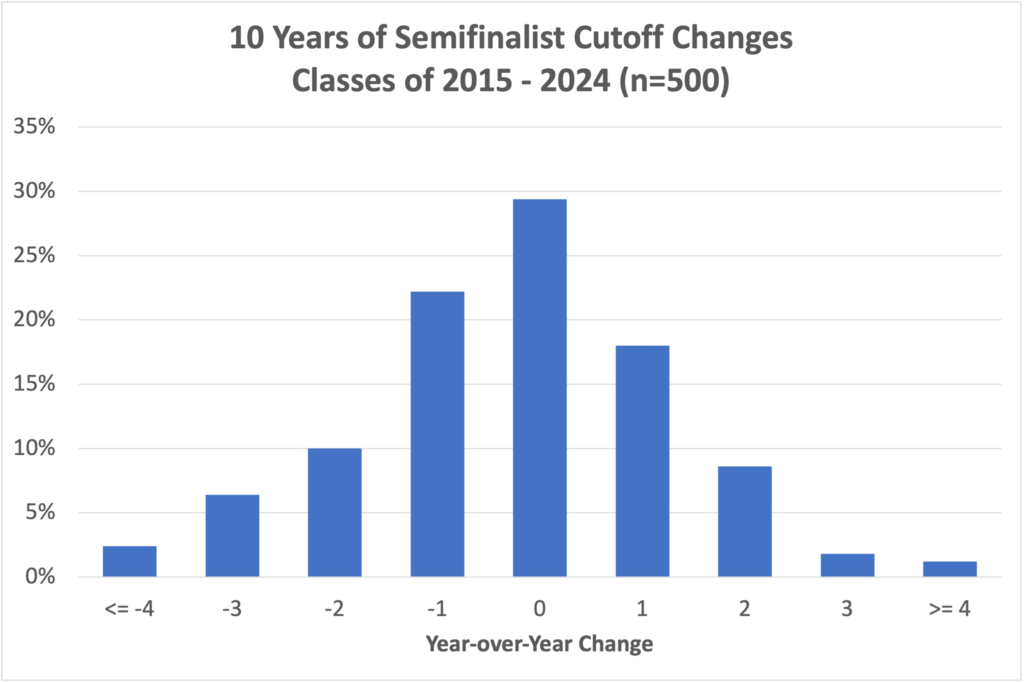
We believe that a table of results from this class will skew to the right.
Small states have more volatile cutoffs than large states, but there can be surprises across the board. The PSAT had a significant overhaul in scoring in 2017. If we look at the minimum and maximum cutoffs during the 9-year period from then until the class of 2025, we see that the 13 largest states (about 100,000 or more high school graduates) average a 2.8-point differential. New Jersey has a 1-point differential, since its lowest cutoff is 222 and highest is 223. The smallest states (fewer than 30,000 graduates) have a 6.2 point differential. Alaska has been as low as 208 and as high as 217! The medium-sized states average a 5-point difference between minimum and maximum.
Here are Compass’s current estimates for Semifinalist cutoffs for the class of 2026:
State | Class of 2026 Estimated Range | Class of 2026 Most Likely | Class of 2025 (Actual) | Class of 2024 (Actual) | Class of 2023 (Actual) | # of 2025 Semifinalists |
|---|---|---|---|---|---|---|
| Alabama | 210 - 216 | 214 | 212 | 210 | 212 | 267 |
| Alaska | 210 - 216 | 214 | 214 | 209 | 210 | 36 |
| Arizona | 215 - 220 | 218 | 217 | 216 | 214 | 401 |
| Arkansas | 210 - 215 | 213 | 213 | 210 | 210 | 134 |
| California | 220 - 223 | 222 | 221 | 221 | 220 | 2103 |
| Colorado | 216 - 221 | 218 | 218 | 216 | 217 | 272 |
| Connecticut | 220 - 222 | 221 | 221 | 221 | 221 | 177 |
| Delaware | 218 - 221 | 220 | 219 | 219 | 218 | 43 |
| District of Columbia | 222 - 224 | 223 | 223 | 223 | 223 | 47 |
| Florida | 216 - 220 | 218 | 217 | 216 | 216 | 972 |
| Georgia | 217 - 221 | 219 | 218 | 217 | 218 | 624 |
| Hawaii | 215 - 220 | 218 | 217 | 217 | 215 | 74 |
| Idaho | 212 - 217 | 214 | 213 | 211 | 215 | 102 |
| Illinois | 218 - 222 | 220 | 220 | 219 | 219 | 738 |
| Indiana | 214 - 219 | 217 | 217 | 216 | 214 | 304 |
| Iowa | 211 - 217 | 214 | 212 | 210 | 212 | 156 |
| Kansas | 213 - 219 | 216 | 215 | 214 | 214 | 142 |
| Kentucky | 211 - 217 | 214 | 213 | 211 | 212 | 202 |
| Louisiana | 212 - 217 | 215 | 214 | 214 | 213 | 238 |
| Maine | 212 - 217 | 215 | 214 | 213 | 215 | 53 |
| Maryland | 221 - 224 | 222 | 222 | 221 | 222 | 296 |
| Massachusetts | 221 - 224 | 223 | 223 | 222 | 220 | 294 |
| Michigan | 216 - 220 | 218 | 218 | 217 | 218 | 511 |
| Minnesota | 216 - 220 | 218 | 217 | 216 | 216 | 288 |
| Mississippi | 210 - 215 | 213 | 212 | 209 | 210 | 155 |
| Missouri | 214 - 218 | 216 | 215 | 214 | 213 | 276 |
| Montana | 208 - 213 | 210 | 209 | 209 | 207 | 45 |
| Nebraska | 210 - 216 | 213 | 211 | 210 | 212 | 118 |
| Nevada | 211 - 218 | 215 | 214 | 211 | 210 | 162 |
| New Hampshire | 214 - 219 | 217 | 217 | 215 | 213 | 55 |
| New Jersey | 222 - 224 | 223 | 223 | 223 | 223 | 474 |
| New Mexico | 209 - 215 | 212 | 211 | 207 | 208 | 94 |
| New York | 219 - 221 | 220 | 220 | 220 | 219 | 1089 |
| North Carolina | 216 - 220 | 218 | 218 | 217 | 217 | 518 |
| North Dakota | 209 - 213 | 210 | 210 | 207 | 209 | 28 |
| Ohio | 215 - 219 | 217 | 217 | 216 | 216 | 582 |
| Oklahoma | 209 - 215 | 212 | 211 | 208 | 211 | 214 |
| Oregon | 215 - 220 | 217 | 216 | 216 | 216 | 205 |
| Pennsylvania | 217 - 221 | 219 | 219 | 219 | 218 | 583 |
| Rhode Island | 213 - 220 | 217 | 217 | 215 | 216 | 50 |
| South Carolina | 210 - 217 | 215 | 214 | 209 | 213 | 234 |
| South Dakota | 209 - 214 | 211 | 208 | 209 | 212 | 41 |
| Tennessee | 215 - 219 | 218 | 217 | 217 | 215 | 319 |
| Texas | 218 - 221 | 220 | 219 | 219 | 219 | 1714 |
| Utah | 210 - 216 | 213 | 211 | 209 | 211 | 195 |
| Vermont | 211 - 217 | 215 | 215 | 212 | 213 | 33 |
| Virginia | 220 - 223 | 222 | 222 | 219 | 221 | 394 |
| Washington | 220 - 223 | 221 | 222 | 220 | 220 | 358 |
| West Virginia | 209 - 212 | 210 | 209 | 207 | 207 | 66 |
| Wisconsin | 213 - 217 | 215 | 214 | 213 | 213 | 289 |
| Wyoming | 209 - 213 | 211 | 209 | 207 | 207 | 24 |
| U.S. Territories | 209 - 211 | 210 | 208 | 207 | 207 | 45 |
| Studying Abroad | 222 - 224 | 223 | 223 | 223 | 223 | 112 |
| Commended | 209 - 211 | 210 | 208 | 207 | 207 |
If you’d like to see even more historical data, you can find cutoffs going back to 2008 in Compass’s National Merit Historical Cutoffs.
Why does each state have its own Semifinalist cutoff if the program is NATIONAL Merit?
This is always a hot button question. NMSC allocates the approximately 17,000 Semifinalists among states based on the annual number of high school graduates. That way, students across the nation are represented. It also means that there are very different qualifying standards from state to state. A Massachusetts student with a 220 might miss out on being a Semifinalist. If she lived 10 miles away in New Hampshire, she would qualify.
NMSC sets a target number of Semifinalists for a state. For example, California sees about 2,000 Semifinalists every year, Michigan 500, and Wyoming 25. In each state, NMSC determines the Selection Index that comes closest to matching its target number of Semifinalists. If 1,900 California students score 222 and higher and 2,050 score 221 or higher, then the Semifinalist cutoff would be 221 (this assumes that the target is exactly 2,000). Because score levels can get crowded, it is easy for cutoffs to move up or down a point even when there is minimal change in testing behavior or performance.
No Semifinalist cutoff can be lower than the national Commended level. Cutoffs for the District of Columbia and for U.S. students studying abroad are set at the highest state cutoff (typically New Jersey). The cutoff for students in U.S. territories and possessions falls at the Commended level each year. Boarding schools are grouped by region. The cutoff for a given region is the highest state cutoff within the region.
Why does the number of top scorers vary from year to year?
While there are changes in the number of students taking the PSAT/NMSQT, there can also be small flaws in test scaling that play a role. Prior to the digital PSAT, a single test form was seen by a large percentage of test takers. Something amiss with that single form could impact selection cutoffs across the country. The digital PSAT is constructed differently. Students receive unique form codes drawn from a large pool of problems. Scaled scores are generated based on the characteristics of those problems. In theory, this should make scores more stable. College Board’s early studies have found an extremely high correlation between the paper-and-pencil test and digital test. Still, even with its adaptive nature, the uncertainty remains as to whether the much shorter test can reliably score students at the 700-760 end of the scale.
What if I missed the PSAT because of illness or other legitimate reason?
You may still be able to enter the scholarship program by applying for Alternate Entry using an SAT score. Find information about last year’s process in Compass’s explanation of National Merit alternate entry.
When are National Merit Semifinalists announced?
The Commended cutoff becomes unofficially known by the end of April. The lists of Semifinalists are not distributed to high schools until the end of August. NMSC sets a press embargo on Semifinalist announcement until mid-September, but schools are allowed to notify students before that date. NMSC does not send Commended Student letters to high schools until mid-September. Compass will keep students updated on developments as those dates approach.
Do state and national percentiles indicate whether I will be a National Merit Semifinalist?
No! Approximately 1% of test takers qualify as Semifinalists each year, so it is tempting to view a 99th percentile score as indicating a high enough score — especially now that College Board provides students with percentiles by state. There are any number of flaws that rule out using percentiles as a quick way of determining National Merit status.
- Percentiles are based on section scores or total score, not Selection Index
- Percentiles are rounded. There is a large difference, from a National Merit perspective, between the top 0.51% and the top 1.49%
- Percentiles reveal the percentage of students at or below a certain score, but the “at” part is important when NMSC is determining cutoffs.
- The number of Semifinalists is based on the number of high school graduates in a state, not the number of PSAT takers. Percentiles are based on PSAT takers. States have widely varying participation rates.
- Most definitive of all: Percentiles do not reflect the current year’s scores! They are based on the prior 3 years’ performance. They are set even before the test is given. And if you are going to use prior history, why not use the completely accurate record of prior National Merit cutoffs rather than the highly suspect percentiles?
Entry requirements for National Merit versus qualifying for National Merit.
Your PSAT/NMSQT score report tells you whether you meet the eligibility requirements for the NMSP. In general, juniors taking the October PSAT are eligible. If you have an asterisk next to your Selection Index, it means that your answers to the entrance questions have made you ineligible. Your answers are conveniently noted on your score report. If you think there is an error, you will also find instructions on how to contact NMSC. Meeting the eligibility requirements simply means that your score will be considered. Approximately 1.4 million students enter the competition each year. Only about 53,000 students will be named as Commended Students, Semifinalists, Finalists, or Scholars. See National Merit Explained for more information.

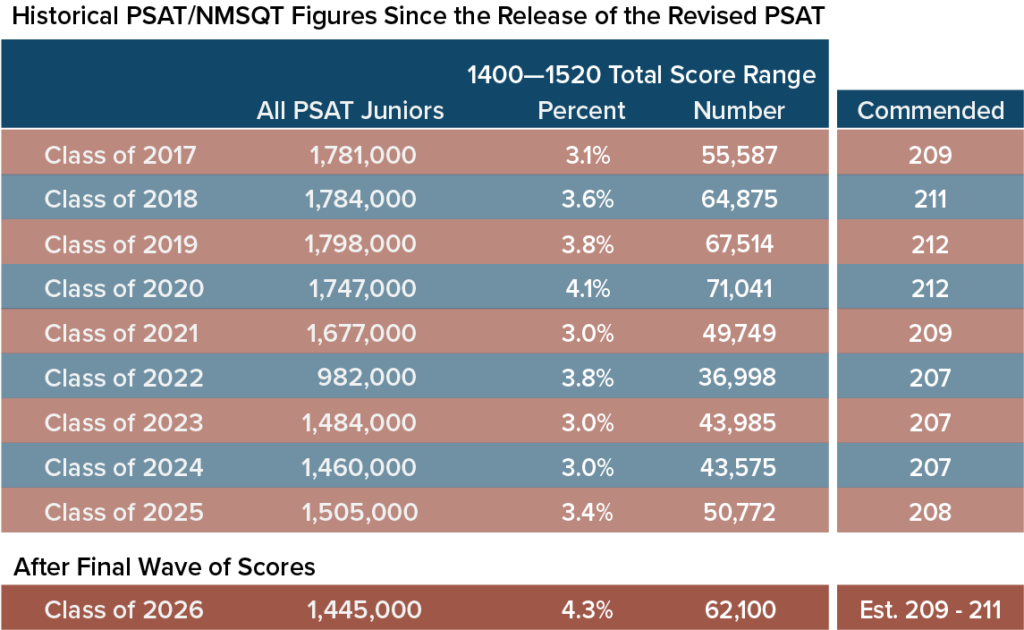
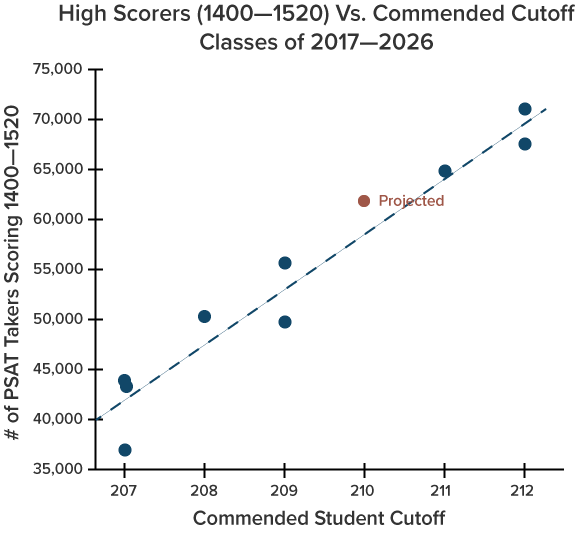
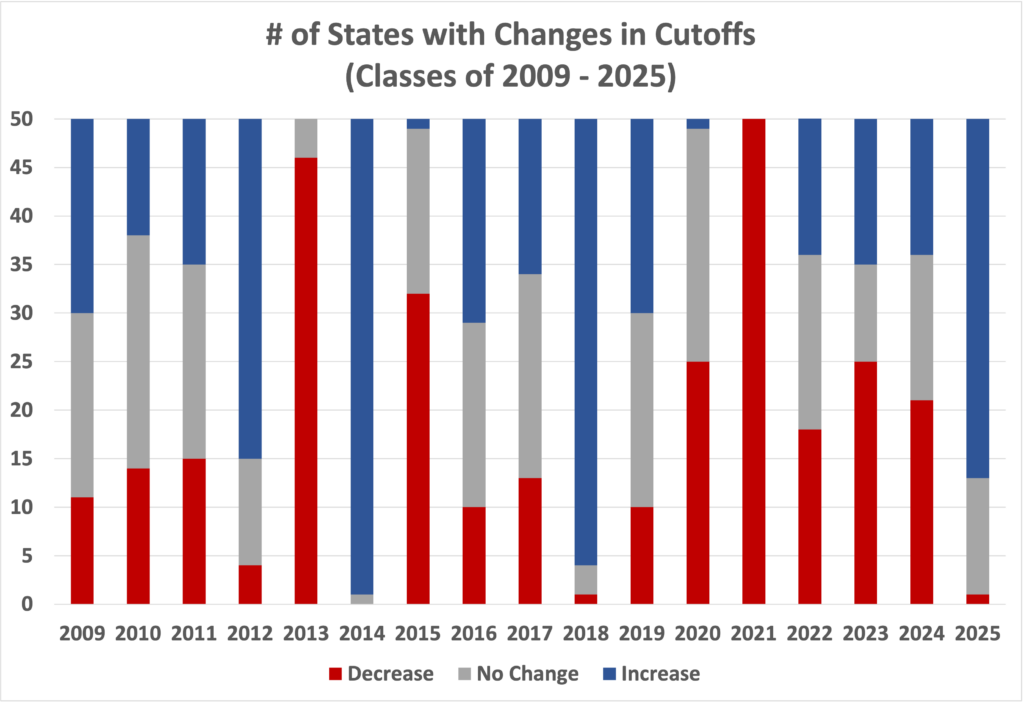
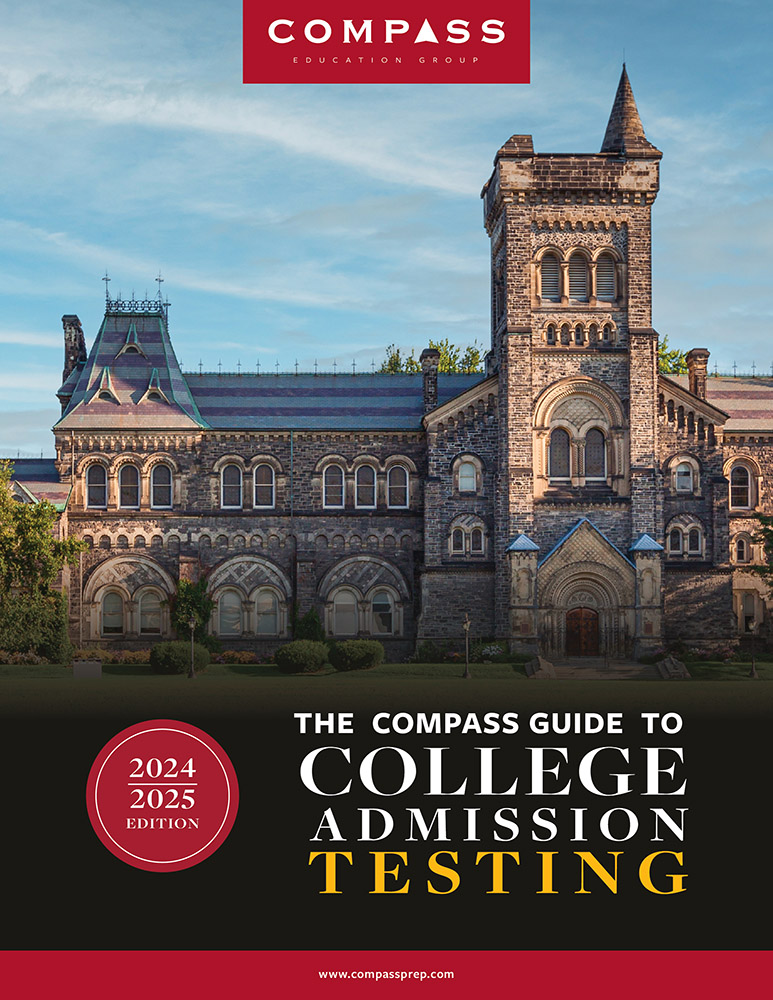
Hi Art,
So abroad students will only get confirmation after all the state cutoff’s are finalized. What’s the likelihood of 221 making it.
K,
Yes, hopefully we’ll get a complete list at some point. The key states to be on the lookout for are New Jersey, Massachusetts, and Maryland. [Edit] A 221 is possible if the low marks end up capping all those cutoffs. The last time that happened was with the class of 2013.
Mr. Sawyer,
Apologies for disturbing you, but I am deeply concerned whether I will become a semifinalist or not. I am from Oklahoma with a 211 index score, but the “most likely” is 212. What would you say my chances are when it comes to this? I am really hoping I pull through with this one. Thank you in advance!
Matt,
I tend to be conservative with my “most likely.” As a small-ish state, Oklahoma’s cutoff can bounce around. We saw 212 last year, but it was 211 and 210 in prior years. I’d stay optimistic.
Art, my index score is 212; I am from Oklahoma. What would you estimate my chances to be?
So far we seem to be on trend for what we were expecting — a low year nationally. I think it’s unlikely that we’d see a 213 in OK, so you’re in great shape!
213 has qualified in Oklahoma…
Thank you for the information!
Thanks for this great info! My TX kid is thrilled with his 222.
Congratulations!
I qualified as a 224 from Florida. Is my 1540 SAT superscore too low to confirm? I’m planning on submitting my 36 ACT instead.
Caleb,
Your 1540 is and 36 are both MORE than high enough. The confirming score is basically set at around the Commended cutoff. I think your ACT score is higher, but keep in mind that the Science score doesn’t count. If you had a 35E 35M 36R, it might be close (I admit that I haven’t done the math). You can find more information on our National Merit FAQ and see how the scores convert using a concordance.
My daughter’s 217 qualified in Mississippi.
Congratulations to your daughter!
My son has 215 in Ohio. he hasn’t heard from his school yet. Who should he be contacted, if at all?
Muhammed,
I would wait until next week and then check with your counselor. Some schools don’t inform students until names are released to the press. This was on September 15th last year. If they stick to Wednesday, it would be September 14th this year.
Do you know where to find the names of past NMSF? I used google but ended up no luck. Thank you.
NMSC does not publish a publicly available list. Instead, it sends state lists to press outlets around the country. It’s up to those organizations to decide how (or if) to publish the information. Some post the full PDF. Helpful Redditors sometimes compile a list such as this one: https://www.reddit.com/r/psat/comments/ipmq79/lists_of_semifinalists_by_state/.
What will be the score for Ohio? Do you think he can qualify?
I don’t have any information yet. It’s likely to be in the 214-216 range. Hopefully it stays at 215.
213 qualified in Nebraska.
Thank you!
I have a friend in Missouri who scored a 212 and did not make it.
Thank you, Calvin. I’ve marked Missouri confirmed at 213.
Hi Art!
I have a 221 in Texas, so I should qualify based on what people have reported here. I am planning on using my ACT score to confirm finalist status, but I read in another comment that the science section doesn’t count. I have a 35 composite: 36E, 33M, 35R, 36S.
Should I use my 1490 SAT score or my ACT without science?
Thanks!
Ethan,
Both you SAT and ACT scores are high enough to be confirming scores. Your ACT score is probably a little higher. I can only say probably because you didn’t mention the ERW/M split. NMSC uses the Selection Index formula of doubling the ERW score. Your ACT converts to a 770 ERW and a 740 M, so your SAT Selection Index is 228 (77 x 2 + 74). We have more details in our National Merit FAQ.
Not super helpful, but 223 qualified in Illinois
It’s good news for someone. Thanks!
Any news on Kentucky. We have a 214 trying to ascertain
Not yet, John. One of the problems is that once students’ find out that they have qualified, they become far less concerned about cutoffs. Word won’t get out at many schools until after Labor Day.
Thanks for these updates. We’re excited over here as we’ve been watching for your updates. We are in California and my son has a 222. Yay!
Congratulations to your son, Janna!
I made it with a 219 in Tennessee
Congratulations, Niles.
Let’s go Niles! I made it too with a 218 in TN
Congratulations, Jackson!
218 just qualified in Arizona, hope this helps
Thank you, Akhil! I’ve entered Arizona.
218 qualified in Tennessee. What would a confirming Act score be? I have a 33 math 34 english and a 36 reading.
Congratulations, Matthew! You have to convert the components of an ACT score into an SAT score and form a Selection Index. That number should be at least as high as the Commended Figure of 207. You can check our National Merit FAQ for the formula and a link to the concordance table. You are somewhere in the mid-220’s, so it is not an issue.
My daughter’s 213 qualified in Arkansas
Congratulations to your daughter! I’ve updated the highest possible AR cutoff.
My son’s 220 qualified in Washington State
Congratulations to your son, Dave! The 220 will be welcome news to many folks, since WA has been one of the top 10 cutoffs recently.
Is 207 the confirmed commendable cutoff for this year?
Julia,
Yes, we were able to confirm the Commended cutoff in the spring.
Just saw on Reddit that IL had a 222 that qualified. I have a 221 so fingers crossed that we get news of it dropping further in the next few days here 🙂
I’ve got solid information that your 220 will qualify!
Hi Art. Are you referring to IL? My daughter had exactly a 220, so that would be great news!
Yes, Illinois is 220 or lower. Congratulations to your daughter!
Ooooh…here’s hoping for the “or lower.” My daughter has a 219 and we’ve been refreshing this page for a couple of days!
I’m trying to get final confirmation soon on IL.
That’s a relief for me! My son had a 222, and we are still waiting to hear. I saw the 223 score this morning (which has since been lowered to a 220) and was really bummed!
I qualified with a 215 in Idaho.
Thank you, S!
My son’s 218 qualified him to be a Semifinalist in North Carolina.
Congratulations to your son, Sandi. Thank you!
Probably not too helpful, but I heard a 221 qualify in Ohio on reddit.
Thanks for passing it along, RL.
Not real helpful, but I qualified in Texas with a 220, not new data but it should help some still anxious people.
It’s always nice to get added reports. Congratulations, Mavo!
Congratulations! May I ask how you were notified? Did you get an email?
Would you still officially be considered a semifinalist if you get above the cutoff (219 in NC) but as a sophomore not a junior? Maybe a Semifinalist who cannot be a finalist because they were not a junior? Or do you just get street cred and hope it was not a fluke when you take the test as a junior next month?
DJ,
Only juniors participate in the NMSQT part of the PSAT/NMSQT. So, yes, just street cred and confidence for next month’s test.
I have heard that the PA cutoff is 218 on Reddit!
Updated. Thank you!
I’m unable to find this on Reddit…can you post the link? My son is 217, so a 218 cutoff is crushing.
Phil, I’m sorry to hear that your son missed out on NMSF. I’ve confirmed that the Reddit information is correct and that Pennsylvania’s cutoff is 218 this year.
Thanks Art
Phil, been there, done that with kiddo #1. Missing by one point really hurts, but he will be fine. Best of luck to him!